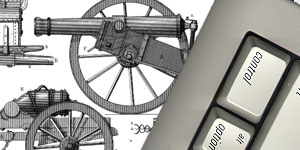


On the Bleeding Edge
In war, electronics can make the difference between life and death. A basic thirty-kilometer radar in your warplane might cost a quarter of a million dollars. Doubling the price can increase its accuracy and extend your sight to forty kilometers, letting you spot attackers sooner. Doubling the price again allows you to see seventy kilometers ahead, lets your radar guide your missiles, and gives you better tracking and safer low-altitude flying. Double the price yet again---to two million dollars---and you get vision out to almost two hundred kilometers and better ability to see through sophisticated electronic defenses. Similar escalations hold for the missiles you're about to fire and the warplane you're flying in.Even the lowly bullet might eventually get its own computer. Every modern air, sea, or land warcraft needs computers---to help it sense its environment, target and deliver its weapons, move itself around, and support its crew. Electronics goes into satellites, planes, helicopters, missiles, ships, submarines, tanks, armored vans, artillery, and on, and on, and on.
All those computers cost money. America's newest attack submarine, for instance, costs 2,100 million dollars. And its newest stealth bomber costs another 2,200 million. Such enormous quantities of money give rich nations a significant military edge. The more they spend, the safer their troops are. Every commander who has to lead troops into battle and be held responsible for their lives wants the best equipment money can buy---and no one wants to tell the taxpayers that they're trading today's dollars for tomorrow's body bags.
Before the 1991 Gulf War, everyone sold weapons, equipment, expertise, and supplies to Iraq. America and Britain both provided nuclear technology, electronic warfare devices, and very large guns. Chile sold ammunition and bombs. France sold advanced aircraft, missiles, electronics, and nuclear reactors. Germany sold chemical weapons technology and electronics expertise. China sold missiles, bombs, and artillery. The Soviet Union traded three thousand tanks and five hundred aircraft. South Africa sold large-bore artillery. Brazil sold rocket launchers and armored cars. In just five years, Iraq spent over forty thousand million dollars. Everyone made a buck. At least, until the fighting started. The resulting war then cost America alone sixty thousand million dollars.
Modern war is definitely not for the poor. During the 1980s, America alone spent two million million dollars on its armed forces. Worldwide, weapons costs alone now make up about half of all military spending, and more than a third of that goes for electronics. Even though the Cold War is over, overall military spending on electronics is rapidly approaching 20 percent of the world's military budgets. All countries combined presently spend around a million million dollars a year on their armed forces. (That's more than all warring nations spent in 1944, the year of heaviest fighting during the Second World War.) Military electronics alone will thus soon consume almost two hundred thousand million dollars a year---and the amount can only increase. Nobody wants to lose the next war.